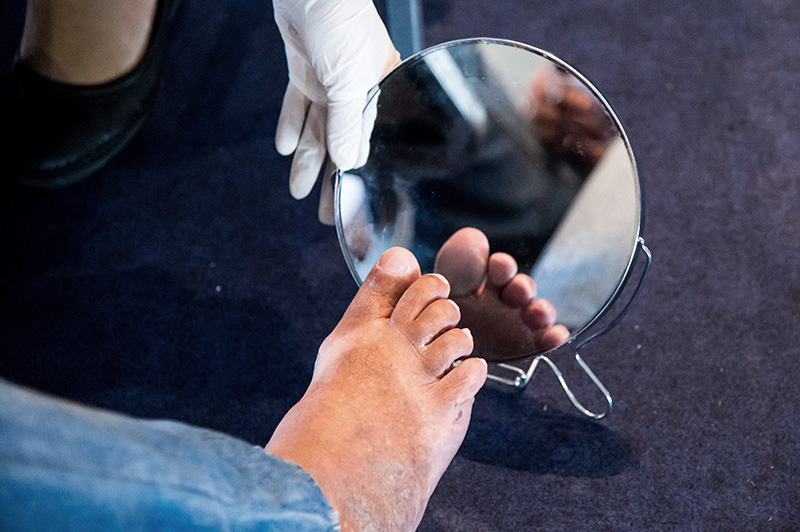Diabetic mellitus is one of chronic diseases that can result in several complications. One of serious complications is diabetic neuropathy that eventually leads to “diabetic ulcer”. With damaged nerves mainly in the feet and legs, diabetic ulcers are prone to be infected easily with poor healing. To prevent or delay diabetic ulcer and its complications, it is highly recommended to keep control of blood sugar level and take good care of the feet and legs.
Get to know diabetic ulcers
In patients with diabetes mellitus or DM, years of poorly controlled hyperglycemia (high blood sugar level) primarily lead to vascular complications that damage peripheral nerves, small blood vessels (microvascular complications) and large blood vessels (macrovascular complications). Uncontrolled high blood sugar damages nerves and interferes with their ability to send signals, leading to diabetic neuropathy. Diabetic neuropathy is the result of nerve ischemia due to microvascular disease, direct effects of hyperglycemia on neurons and intracellular metabolic changes that impair nerve function. High blood sugar also weakens the walls of the small blood vessels (capillaries) that supply the nerves with oxygen and nutrients, resulting in impaired ability of wound healing. Symptoms include numbness or reduced ability to feel pain or temperature changes, unrecognized ulcers in the feet or legs such as ingrown toenail which is a typical cause of infection.
With impaired ability in pain sensation, an infected cut or sore on the foot or leg will not be recognized until its size gets noticeably larger with slow process of would healing. Additionally, impaired nerve function subsequently induces the malfunction of muscles which eventually causes misshapen feet, ulcers with severe infection or gangrene. In such a case, amputation of toe, foot or leg might be required.
Patients at greater risks to develop diabetic foot ulcers
Anyone who has diabetes can develop diabetic neuropathy including diabetic foot ulcers. However, the risk are higher in patients with poor blood sugar control for at least 5-10 years. Apart from long-term uncontrolled blood sugar level, other risk factors include cigarette smoking and advanced age. Nevertheless, diabetic foot ulcers can be prevented up to 85% if appropriate and timely foot care is promptly provided at the earliest stage of foot ulcers. General foot screening and wound care programs are essentially suggested in all patients diagnosed with diabetics.
Taking good care of diabetic foot ulcers
Diabetic neuropathy and diabetic fool ulcers can be delayed or prevented by keeping tight control of blood sugar level and taking good care of feet. Foot care includes checking feet every day, looking for blisters, cuts, bruises, cracked and peeling skin, redness and swelling. It is highly recommended to use a mirror or ask a friend or family member to help examine parts of feet that are difficult to see. It happens very often that patients cannot notice any wounds due to impaired sensation. Feet must be clean and dry while feet soaking should be avoided. There are 2 major complications of diabetic foot ulcers:
- Blood vessel stricture and nerve ischemia result in reduced blood supply to the legs and feet. Manifestation that indicates insufficient blood flow is moderate to severe calf pain even after walking for a short distance. If this condition is left untreated, it eventually causes chronic ulcers which will not heal. The severity depends entirely on the degree of ischemia and infection. If foot ulcers are found in diabetic patients, immediate medical attention must be sought as soon as possible.
- Diabetic patients with uncontrolled blood sugar level are prone to have poor blood circulation and impaired wound healing. As a consequence, the foot ulcers tend to be infected very easily.
Diagnosis of diabetic foot ulcers
- A doctor can usually diagnose diabetic foot ulcers by performing a full physical examination and carefully reviewing related symptoms and patient’s medical history. The physical examination involves overall muscle strength and tone, tendon reflexes and sensitivity to touch. A comprehensive foot exam includes checking for foot sores, cracked skin and blister.
- The ankle-brachial index (ABI) test to identify the ratio of the blood pressure at the ankle to the blood pressure in the upper arm (brachial artery). Compared to the arm, lower blood pressure in the leg (less than 0.9) suggests blocked arteries that supply blood to the legs and the feet.
- Determination of oxygen level in blood to evaluate the oxygen sufficiency that essentially requires in wound healing process. The state of wound oxygenation is a key determinant of infectious possibility and wound healing outcomes.
- A Doppler ultrasound to evaluate blood circulation. It is a test that uses high-frequency sound waves to measure the amount of blood flow through arteries and veins, usually those that supply blood to arms and legs. Vascular flow studies can detect abnormal flow within blood vessel that circulate blood to the feet.
- CT angiogram with contrast is a test that uses X-rays to provide detailed pictures of the blood vessels in order to identify vessel ischemia and obstructive areas.
Treatment of diabetic foot ulcers and diabetic neuropathy
Treatments for patients with diabetic foot ulcers and diabetic neuropathy include:
- Consistently keeping blood sugar within target range is the key for preventing or delaying nerve damage. Uncontrolled blood sugar level leads to nerve damages, poor immune function and blood circulation as well as higher risks of wound infection with impaired healing process.
- Balloon angioplasty is an interventional procedure to restore blood flow in the legs or feet of patients with advanced diabetes. During the procedure, a tiny balloon is inserted at the site of the blockage. It widens the narrowed artery and restores blood supply to affected areas. This approach saves patients from amputation. Compared to bypass surgery which is major operation that requires the removing of blood vessel from the chest, arms or legs and using it to create a detour or bypass around the blockage, balloon angioplasty can be performed safely in the elderly with underlying diseases since this procedure is considerably less invasive without major surgery. Nevertheless, the selected approach depends on the severity of the vessel blockage and patient’s individual conditions.
To prevent diabetic foot ulcer and slow its progression, a comprehensive foot care provided by expert endocrinologists remains essential. It significantly helps to reduce risks of wound infection, disease severity and its complications as well as improve patient’s quality of life and spare amputation.
Although diabetic foot ulcer is a common and serious complication of diabetes, it is mostly preventable if blood sugar level is well kept in the target range. To protect the health of the feet, it is highly advised to check the feet everyday and keep them clean and dry, apply moisturizing lotion or cream to preserve skin tone and prevent cracked skin. For misshapen feet, customized shoes that properly fitted are recommended to wear in order to prevent problems such as ulcers, corns and calluses. Even small sores can quickly turn into severe infections if left untreated. As soon as foot ulcers are noticed, medical assistance must be sought immediately.







